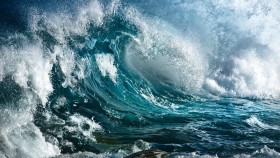Claire Thompson
Study probes copper risk to “Goldie Locks” marine life
Claire Thompson's PhD program at the Research School of Earth Sciences involved filling gaps in our knowledge about the impact of the trace element on the photosynthetic microorganisms.
Phytoplankton are critical to marine ecosystems, and are pivotal to carbon sequestration in the oceans, which form the biggest carbon dioxide sinks.
However, little is known about the complex biochemistry of the organisms.
Thompson says copper in trace amounts is essential to phytoplankton but toxic in higher concentrations.
Among natural sources of copper in seawater are "black smokers", or hydrothermal vents, sites on the ocean floor from which superhot water gushes from the strata below.
"Phytoplankton have been labelled the Goldie Locks organisms when it comes to copper," she says. "The concentration of the metal have to be just right."
Thompson is to study the impact of various concentrations of copper on phytoplankton in laboratory studies.
She will measure the isotopic compositions of copper in plankton, which inhabit the top 200 metres of the water column, to see which species take up the metal.
She will also study natural defences deployed by some phytoplankton against assaults from the element.
Some species release "organic chelators", compounds that mop up excess copper around them to make their environment safe.
But little is known about the process, and it is unclear how strong this natural defence is.
Later, she intends to turn her attention to urban sources of copper pollution to gauge their effect on local photosynthesis rates.
Claire was accepted into the Graduate Program at Geoscience Australia after completing her PhD.








